How Not To Shoot an Elk
by Wayne van Zwoll
To kill elk, you must shoot well — and sometimes again. But first you must find them.

LAST WEEK as I write this I returned from an elk hunt.
Predictably, the snow that most Novembers nudged big bulls from the hills was this year absent. Three days hiking the steeps yielded but one glimpse of branched antlers. No shot. One morning a rock that weighed as much as a Harley cruiser and no doubt had rested, unmoving, since the Pleistocene, gave way under my step. The hillside tore my shoulder.
With two days remaining, the elk had a commanding lead.
But if you’re an elk hunter, you dismiss the score. Optimism keeps you going until all light bleeds from the sky at dusk the last day …
____________________
Hung up on ballistics?
There are many ways not to shoot elk. Many hunters now talk less about hunting than about rifles and loads — as if getting a shot is just preparation for the main event. In truth, finding elk is almost always harder than bringing one to bag.
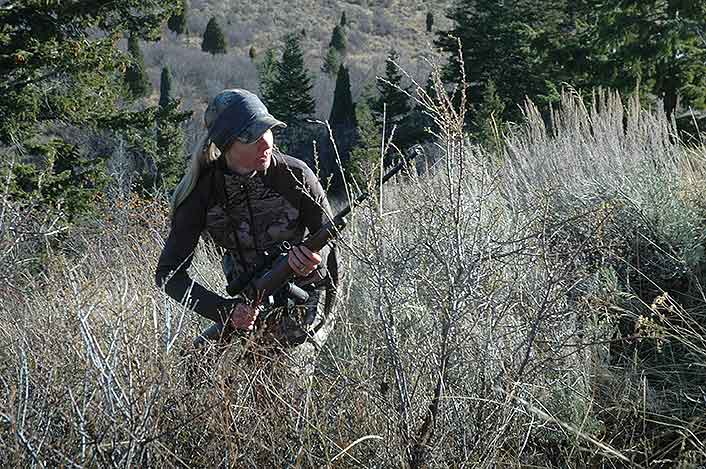
Elk are mobile and in many places migratory. Distance between herds and sequestered bulls can leave you looking at empty country until you figure out where the elk are now. Oddly, many hunters ply ridgetops, glassing meadows and slides for a long poke from a rock rest. They’re looking for a place to kill an elk, or for a shot they’ve dreamed about, rather than for the elk. Easily accessible coverts seldom hold big bulls; and you’ll find few elk trails on spines. Most elk live on slopes — gentle, semi-open grades until rifle fire moves them. Canyon guts carry elk traffic but have poor day-time wind coverage. Running water there also drowns the sounds of approaching danger. Only “holes” that discourage hunters hold elk.
Traveling elk prefer established trails. You’re smart to follow suit. Trails offer easy, quiet access to thickets. When you do make noise, elk — themselves noisy — may discount it. I’ve surprised many bulls, just by moving as if I were an elk. On trails, you can throttle up. Fast travel can help you in country with low elk densities or after a herd has been blown, or if you must circle to get the wind.
You’re smart to hunt near where you think elk live. When I see hunters glassing over the top of elk cover onto distant ridges, I wonder why, if they expected to see elk yonder, they didn’t hunt yonder. Once, topping a hill, I spied through the trees a patch of second-growth on the slope opposite. Surrounded by tall timber, it was just the place to find elk! I put my binocular to work. Then, short yards away, a hoof thumped. I glimpsed the bull as he slipped into cover. He’d been standing in the open as I looked far off.
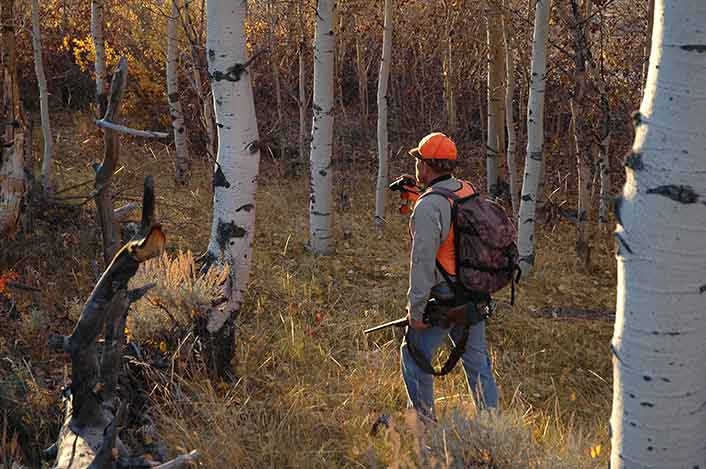
When still-hunting, cover and topography dictate my pace. Where you expect to see elk, slow is good. Creeping through an open basin, however, is a waste of time. When animals obviously aren’t there, you’re simply giving hidden elk more chances to see you as you burn valuable minutes. Easing to ridge-top after a pause to bring your pulse below red-line can help you ambush elk and make an accurate shot. But you may be best served climbing that ridge as fast as you can.
As you move, look intelligently. Pause where shade or vegetation hides you. Look with your head still, first with your naked eye, then the binocular. Panning reveals little detail. Consider how an elk looks for danger: it stands stone-still. That way it can catch the slightest movement and resolve detail that would become a blur with a turn of the head. In your binocular, “read” the field left to right, top to bottom.
Remember that elk inhabit little places in big country. Your job is to find those places. “You can sit the saddle as long as you like,” a grizzled packer once told me. “But eventually you just reach the other side.” During hunting season, elk sift to where hunters don’t go. That’s not always far. I’ve packed in 27 miles and run into other hunters. Mid-elevation forest can appeal to elk because it has few places to park pack-trains. Headwater meadows commonly afford stock the grass and water needed for extended stays. For that reason and because hunters there can start each day near the crest of the country, alpine flats get crowded during elk season.
Years back, in Oregon, I pitched off a ridge that carried lots of hunter traffic. Not far down-slope, I probed a clump of young fir. Mist from a low ceiling silenced my step and confined my scent. Suddenly a bull elk rose behind boughs just a few feet away. He stared, unbelieving. He’d found a spot comfortably out of reach of hunters unwilling to drop from ridgetop. In seasons thereafter, I would take four elk there.

In Montana once, my partner and I rode from camp before dawn, past empty meadows. In a steep north bowl we dismounted. Charred lodgepoles jutted from jumbled rock and crusted snow to pierce low, dirty clouds. A bleak place. But within minutes, we spied color. Elk! Far off, the herd was all but hidden by the spars. But the cadaverous trees afforded scant cover for my stalk. Each move that hid me from one animal exposed me to another. At 300 yards I steadied my .270 Weatherby on a deadfall and triggered a shot. The bull sprinted and fell. This remote bowl appealed to elk because it got no hunter traffic. Nightly, the animals foraged on grassy south slopes less than an air mile away — a short trip for elk.
It’s easy not to shoot an elk if you by-pass difficult places. Until you find elk, the rifle you carry matters not at all.
After 36 cartridges …
Forty-two years ago, an Iver Henriksen-stocked Mauser rifle barreled to .300 Holland & Holland downed my first elk. The .300 H&H, or .30 Super, still ranks among my favorite rounds. But if memory serves, I’ve used 36 on elk, not counting different loads for some — and carried rifles in other chamberings on elkless hunts. I’ve shot elk with the .250 Savage and .32 Special and other rounds commonly thought weak. As a hunting guide, I’ve also seen elk crippled with fire-breathing magnums.
You can not kill an elk with any cartridge you can name.
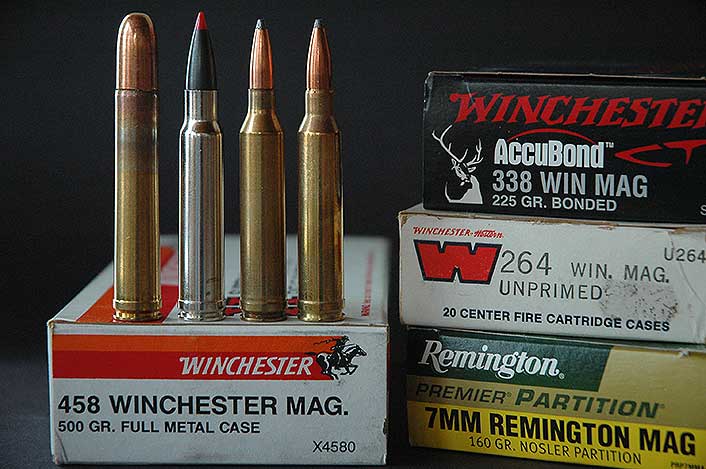
Even if you had the good fortune to take several elk per season, year after year with one load, you would have a hard time drawing conclusions about its effect. Each shot is unique. Range, shot angle and bullet tracks inside the beast vary — as do the weight, stamina and disposition of the elk at the time of the shot. Even small differences in these variables can influence results. In addition, myriad loads are possible for one cartridge. More than 80 types of factory ammunition are sold for .30-06 rifles alone. Many times that number of handloads can be fashioned, with bullets and powders that continue to proliferate.
If you had followed the crowd in picking an elk load during my youth, you’d have chosen the .30-06 or the .270, perhaps the .300 Savage or new .308. Soon other choices arrived. Introduced in 1962 with the Model 700 rifle, the 7mm Remington Magnum featured 150- and 175-grain factory loads. Remington and Wyoming outfitter Les Bowman promoted the round masterfully. Its flat arc and relatively mild recoil appealed to hunters. Still, many thought 150-grain bullets on the light side for elk, while the 175’s weight and blunt nose throttled velocity and sapped downrange punch. Truly, the heavy 7mm load delivered no more reach or power than a 180 Core-Lokt in a stiff .30-06 load. I asked a Remington engineer why Big Green had chosen the 175 over a 160-grain spitzer. “We had a lot of 175s on hand,” was the reply.
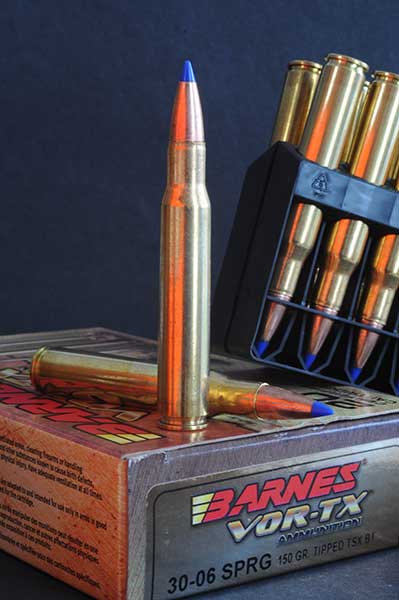
Some years ago, I followed echoes of a bull elk into an Oregon canyon. He climbed out ahead but paused on the rim. I flopped prone. At the snap of my 7mm Magnum he collapsed, spine severed between the shoulders. I’d held too high. The 160 Swift Scirocco had dropped but a hand’s width at 300 yards.
The .300 Winchester appeared a year after Remington’s 7mm. Oddly enough, given expectations of the rabble, it was not the .338 Winchester (circa 1958) necked down. Its 2.62-inch case and short neck gave it more capacity than other (2.50-inch) short belted magnums of the day. It hurled a 180-grain bullet as fast as the 7mm Remington could a 160. Arcs were nearly identical for the same bullet style; of course the heavier .30 hit harder. A 160-grain 7mm Core-Lokt Ultra in a current load brings 1,580 foot-pounds to 400 yards — plenty to kill elk, but well shy of the 1,750 delivered by the .300’s 180, increasingly popular.
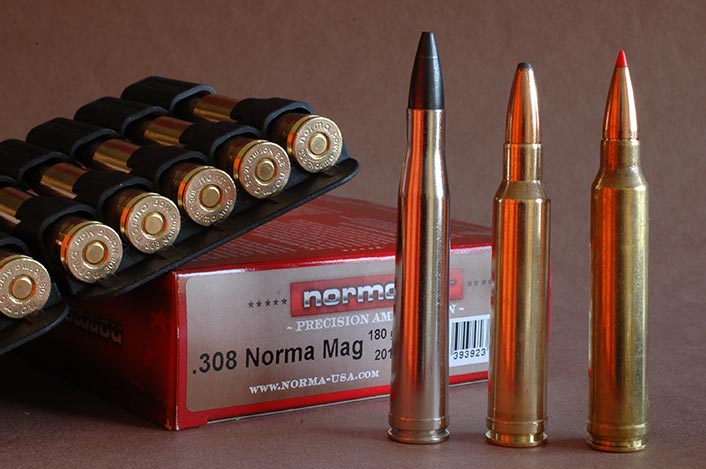
Winchester’s .338 was slow to gain traction, mainly because it seemed unnecessarily powerful, as well as punishing at the shoulder. It is death on elk, equally lethal at distance and on quartering shots in cover. Once I bounced a herd in thick forest. Racing to the thunder, desperate for a wink of antler, I heard hooves behind me. A bull was breaking to my flank! A 250-grain Speer from my .338 staggered him; a second put him down. He’d taken 7,000 foot-pounds from those hits. Another time, horseback in the Bob Marshall Wilderness, I swung down and yanked my .338 from its scabbard as a bull elk trotted for cover across a gulch. My 200-grain Power Point struck mid-rib, angling to the off-shoulder. This elk was dead as it fell.
Better still by ballistic measure: Weatherby’s .340, its 1962 debut buried in the tickertape strewn for the 7mm Remington and .300 Winchester. The .340 is a blown-out, necked-up .300 H&H, untrimmed. It drives a 250-grain bullet faster than an ’06 does a 150! At 500 steps, the .340 hits like a .338 at 400. An elk lunging through Montana shintangle dropped to my Mark V in .340, and a 250-grain Nosler Partition.
Both the .308 and .358 Norma appeared around 1960. I adore both. One morning in the Rockies, I climbed across from a herd I’d spotted at dawn, keeping pace until the bull moved apart in logging slash, 300 yards out. When the Swift A-Frame from my .358 Norma struck, the elk crashed as if the earth had been jerked from under it. Essentially a .338 Magnum with a big mouth, this belted .35 hurls 250-grain bullets faster. The .308 Norma performs like the .300 Winchester, from a case handloaders prefer for its longer neck. One Idaho afternoon my re-barreled Remington 78 in .308 Norma put the skids under a bull. It rolled down a hill to wedge, belly down, between the slope and a fallen tree. A field-dressing challenge!
Heavy artillery hardly ensures instant results. Once, toting a Lazzeroni rifle in 8.59 (.338) Galaxy, I came upon a raghorn bull at 60 yards. He absorbed the bullet with a slight shudder, then moved on into the forest — where, shortly, he died. I got a similar reaction from an elk shot through both lungs with a 300 softnose from a .375 H&H. Such behavior after hard hits have convinced me no bullet knocks elk down. Elk fall when vital organs cease to function or when bullets strike nerve centers or break supporting bone.
A proven way not to kill elk is to assume you missed if the elk doesn’t fall, or to shrug off a hit as superficial before you’ve exhausted all hope of finding the animal.
Sometimes elk die more quickly than you expect. One big six-point, lung-shot by a client with a .270, reared as would a horse, then fell backward, planting its antler tines in the earth and expiring belly up. Another heavy bull, struck a bit far back by a 140-grain .280 bullet, crumpled even as I screeched for the hunter to fire again. Before he could, the bull was dead. I can’t explain those kills.
Lethal bullets, gentle loads …
Not killing an elk is sometimes blamed on the bullet. While bullets vary in terminal behavior and occasionally fail, most hits in vitals kill elk. Bullets serve ably as scapegoats for poor marksmanship.
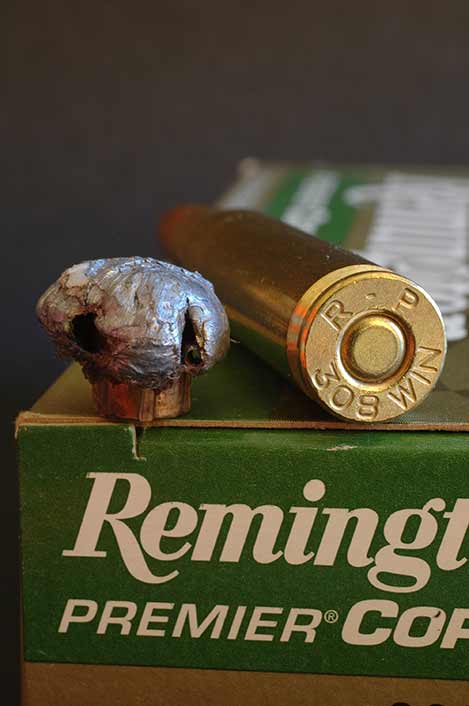
Especially with high-velocity cartridges, bullet design can matter more than listed energy. Some hunters like to see exit wounds, in the event they need a blood trail. I’m ambivalent, so long as the missile reaches the off side. A bullet uses its moxie most efficiently inside the animal, not beyond it. I’m sweet on the double-diameter mushrooms and 90-percent weight retention of Swift A-Frame and Federal Trophy Bonded bullets. Nosler Partitions commonly lose their front ends to upset and fragmentation, but the heel powers on, and the grenade-like action of the nose shreds vitals. Lead-free hollowpoints like Hornady’s GMX and Barnes’s TSX drive as deep or deeper, devastating channels in their wake. Ordinary softnose bullets like Remington’s Core-Lokt and Winchester’s Power-Point, with Speer and Sierra and Hornady softpoints, have killed thousands of elk, several for me. Norma’s bonded Oryx is a fine elk bullet.
However big and tough a rifleman, recoil affects his precision. Loads that rattle your incisors and leave spiderweb cracks in your clavicle affect your marksmanship. Elk are not armored; bullets of modest authority perfectly placed trump magnum hits on the periphery. One rancher I know has killed dozens of bulls with his .250. A pal has used a .25-06 to take 20 elk without losing one. A fellow bringing his young son on his first elk hunt asked me if he should loan the boy his .30-06. “He owns a 6mm Remington, but isn’t that too light?” I looked at the slight lad and allowed that a 6mm would suffice. Next day on a Utah hill the boy sent a 100-grain Nosler Partition through an elk’s heart. A very neat kill.
Some hunters defend hard-kicking loads this way: “I need flat-shooting bullets for long shots, and heavy bullets for the woods.” Driving heavy bullets fast does indeed boost recoil. “Brush-busting” bullets, however, are a myth. Long, heavy missiles (those of high sectional density) spun fast but driven at modest speed resist deflection a bit better than do lightweights or short, thick missiles. But all bullets give way to obstructions. In tests with many bullet types and weights, quick smallbore loads to shotgun slugs, I found none that reliably power straight through sagebrush branches ¼ to ¾ inch in diameter. Targets only a few feet behind showed significant deflection and tipping. “Keyholing” occurred even with 35-bore bullets.

While long-range shooting has developed a cult following, it’s arguably a second-rate finish to a hunt — proof that you lack the skills or ambition to get close. While long shooting can hone fundamentals and teach you a great deal about wind-doping, it’s best practiced, in my view, on paper and steel targets. Game hit at long range may escape before you can fire another accurate shot, and put plenty of country behind it before you reach the impact site. Kills at extreme distance speak well of the equipment used, and the marksmanship of the shooter. But the risk of crippling increases with range.
So I see the need neither for heavy bullets nor high sustained velocities in elk cartridges. Three of my last five elk fell at ranges of less than 55 yards, one at just nine steps. The 280-yard poke that felled a Montana bull this year was far indeed for me. I can think of only four elk I’ve shot at greater distance.
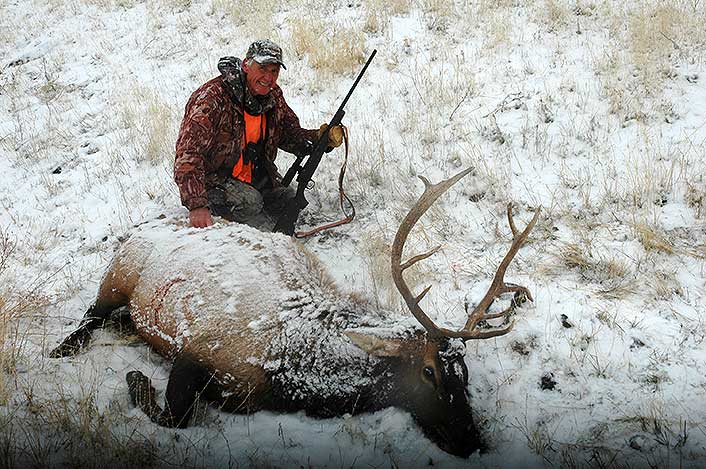
One appeared on a ridgetop apron of grass in Idaho’s Frank Church Wilderness. The Model 71 Winchester I carried was chambered for the wildcat .450 Alaskan, a load ideal in thickets but ill-suited to the task before me. “Take the Ruger,” insisted my pal Ken Nagel, handing me a Number One barreled to 7mm WSM. As time was short, I relented — then raced down toward the elk. The herd beat me to a pass and snaked through a burn toward forest below. I dropped to a hummock, snugged the sling and waited for a cow to move from behind the bull. The bull buckled at the blast, but regained his feet. Thumbing a round home as the thud of a hit floated back, I followed with second and third shots. The bull collapsed. At 330 yards, there’d have been no chance at all with the iron-sighted 71.
That Idaho bull belongs as much to Ken as to me.
These days, I’m drawn to ever more civil cartridges. My biggest elk at this writing fell to the .308 and .30-06 Improved, my most recent to the .280 Remington, .280 Improved and .30-06. From slinged-up prone, I can keep all bullets well inside elk vitals at 300 yards with any of these rounds. I like the .270 and 7mm Weatherby, and the .308 Norma. Sometimes, I power down. This season I carried an 1899 Savage in .303. Its iron sights matched the limits of the load. If killing elk were the only objective in elk hunting, I’d be foolish to pick a 120-year-old cartridge over one of the myriad belted or short magnums, or mid-level bolt-rifle rounds, 7×57 to .35 Whelen. But hunting close to elk, and pasting a bead against ribs in cover is a thrill worth chasing!
Whatever the rifle or load, I try to hew to a 90-percent rule, firing only if under these conditions from this position I can keep nine of 10 shots inside elk vitals — a 16-inch globe between the shoulders.
A compelling way not to shoot an elk is to impose limits on yourself or your rifle that stack odds in favor of the elk. It is how hunting becomes, truly, sport.
____________________
Finishing well. And again.
Last week, my hunt winding down, a storm howled though the Madison. Ray and I scrambled up through the cedars, toward conifers still black. Fat, wet flakes strafed us as a tide of fog splashed against the apron of prairie below. Ray turned for a final look to open country. “Elk.”
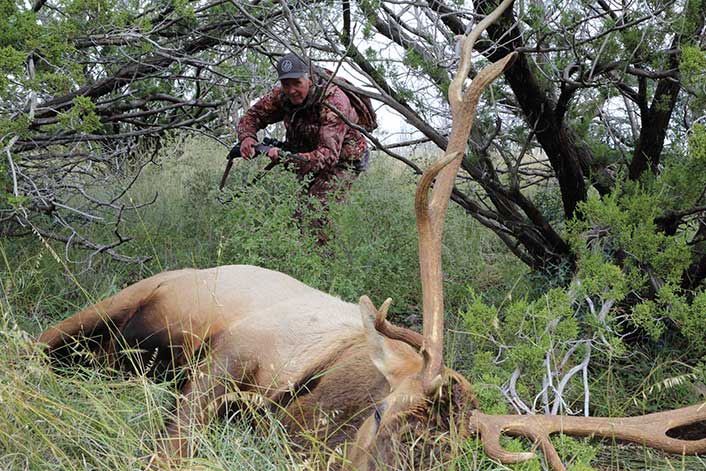
Faint even in the binocular, the herd marched across the flat, crosswind and cautious. “A quarter-mile beyond cover,” I muttered, as my 9x glass picked up one antlered bull. But taller places had left us empty-handed. Ray and I slipped down into the cedars.
For half an hour we paralleled the elk. Then the fog thickened, hiding them. But it also hid us. We chanced a direct approach. When the elk took form again, we huddled behind a cedar. “Too far,” I said. It would have been even in good light, with a place to fire my ’06 from prone, slinged-up.
We crawled, my injured shoulder a hindrance. Just shy of 300 steps a rock offered support. A cow stared. Then other elk looked. Mercifully, the bull sifted from the group. “On the right,” hissed Ray. The Eotech’s reticle steadied, then jumped as my cold-numbed finger milked the last ounce. I didn’t hear a hit. The bull faded into the herd. I cycled the bolt. The herd floated left, then right in the whiteness. The bull again came loose, small, gray, ghostlike. “Left side.” I fired. The tic of bullet on rib came back.
We found the elk dead. Both 180-grain Core-Lokts had landed well. But elk are tough.
A couple of weeks earlier, in another state, I had spotted a bull across a timbered canyon. With a favoring wind, I eased through rain-softened thickets into a burn. By great good luck I came upon the elk undetected and, offhand, sent a Trophy Copper bullet to the shoulder crease. Trees hid the animal as it crashed away. Seconds later it caromed down-slope, to lodge, lifeless, against a charred bole. Still, I did not move, training my rifle for several minutes on what I could see of the elk, ready to fire again.
That habit was ingrained in me long ago, when a pal emptied his magazine into a bull in a thicket, then reloaded and kept hurling bullets until, with no rounds left in pouch or rifle, the animal expired. On a later hunt, I threaded a .30-30 softpoint into a big bull’s chest at 55 yards. The elk spun and dashed off, stopping not far away with only its legs visible under boughs. Unmoving lest it determine the source of its injury, I waited for the animal to collapse. It did not. Glacially, I bellied across the forest floor until the juncture of foreleg and rib came clear. I triggered another round, cycled immediately and loosed a third as the bull’s shoulder cleared the thicket. Seconds later the great six-point fell.
Yet another bull trotted off after I drove a .270 bullet into his forward ribs. A second shot, to the spine, dropped the beast. My first missile had disintegrated soon after entry, damaging only the near lung. Had I not fired again, the animal would doubtless have escaped to die later.
Where a bullet strikes an elk, and how it behaves in its travel thereafter both matter. So does the elk’s disposition at the time. Alas, some if not all such details come clear to you only after the elk is dead. Many elk are lost because hunters fail to follow with more bullets.
“You can’t kill an elk too dead,” a veteran hunter once told me. That is, follow-on hits impose no cost. But they can anchor elk that might otherwise escape. “Keep firing until you see the under-carriage.”
Conserving ammunition after a hit is one more way not to shoot an elk.
A most common way to avoid success
You don’t need much scope magnification for hunting elk. I prefer a fixed 4x. Lighter and shorter and simpler than a variable, it can be mounted lower and usually farther forward. Only in one special case has a high-power variable helped me take an elk. I can’t recall using more than 6x magnification for other bulls; and I keep variables at 3x or 4x. Low power delivers a big, bright field. It subdues the reticle dance that at high magnification you can neither control nor ignore. Hunting with the dial turned down is a habit worth cultivating. And you’ll likely find no need to hike power. Once, with time to burn and a 300-yard shot in the offing, I didn’t bother to bring magnification off the bottom on my 3-9x variable. My softpoint centered the elk’s lungs. But I often had to remind clients to “power down.” One had his sight at 8x when two huge bulls appeared. In the tight field, he couldn’t find either as they made off at 90 yards.
Leaving your variable set at high power may well be the easiest way not to shoot an elk.
Wayne van Zwoll has published 16 books and roughly 3,000 magazine articles on firearms and hunting. Five of his most popular books are: Shooter’s Bible Guide to Rifle Ballistics ($20), Shooter’s Bible Guide to Handloading ($20), Mastering Mule Deer ($25), Mastering the Art of Long-Range Shooting ($30) and Gun Digest Shooter’s Guide to Rifles ($20). Limited numbers are available, autographed, from Wayne at 2610 Highland Drive, Bridgeport WA 98813. Please add $4 shipping.
Stay Connected
- Got a Break in the Montana Missouri Breaks
- It Took Six Days but We Finally Slipped One Past the Bears and Wolves
- No Mule Deer This Fall – Whitetail TOAD!
- An Accounting of Four Idaho Bulls (Elk)
- Arizona Deer Hunt 2019: Good Times with Great Guys
- Caught a Hornady 143 ELDX Last Night
- Cookie’s 2019 Mule Deer Photo Run
- Let’s See Some Really Big Deer
- Alaskan Moose Hunt Success!
- Take a Mauser Hunting: An Important Message From The Mauser Rescue Society!
- Welcome 16 Gauge Reloaders! Check In Here.
- Off-Hand Rifle Shooting – EXPERT Advice
- BOWHUNTING: A Wide One!

